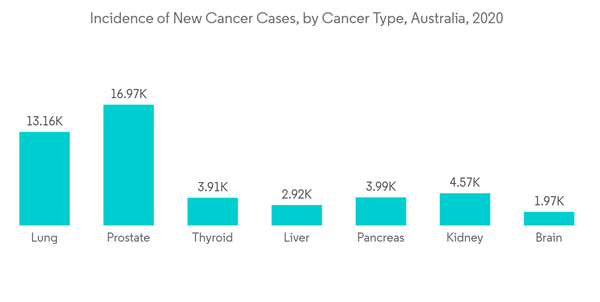The COVID-19 pandemic had a significant impact on the nuclear imaging market in Australia. Various research studies have been published to provide insight into the effects of the pandemic on the studied market. The impact of the COVID-19 pandemic on diagnostic imaging services in Australia, according to research released in July 2020 titled "COVID-19 impact on nuclear medicine: an Australian perspective", showed that nuclear medicine and CT services were relatively less affected than general radiography, ultrasound, and MRI services. Nuclear medicine services were provided less frequently in March 2020 (down 10.1%), April 2020 (down 24.6%), and May 2020 (down 12.3%), with June 2020 (up 11.0%) seeing a notable increase. The country had a severe shortfall in the supply of radiopharmaceuticals during the COVID-19 outbreak, which is anticipated to impede market expansion. A batch of nuclear medicine generators failed the quality check in October 2020, according to an announcement from the Australian Nuclear Science and Technology Organization (ANSTO), which caused a temporary bottleneck in supply. Thus, the market is adversely affected by the pandemic. However, the pending cases are expected to undergo treatment which is expected to increase the market growth in the future.
Technological improvements, expanding diagnostic applications in various diseases such as neurology disorders, government assistance, and the transition from standalone to hybrid modalities are all factors driving the market's growth in Australia. In 2020, Dementia Australia estimates that 459,000 Australians will be affected by dementia. Dementia Australia predicted that by 2058, there will be 1.1 million persons in the world who have dementia. It was the second leading cause of mortality in Australia, the main cause of death for Australian women, and Dementia Australia predicts that it will overtake all other causes of death within the next few years. There is projected to be a significant demand for an accurate diagnosis of the disease given the vast number of people in Germany who live with dementia-related conditions. Since SPECT imaging can be used for the diagnosis of dementia, there is likely to be a demand for this application in the forecast period.
The Appropriate Use Criteria for PSMA PET Imaging were published in September 2021 by the Australia and New Zealand Society of Nuclear Medicine (ANZSNM) and The Society of Nuclear Medicine and Molecular Imaging (SNMMI). These criteria will be a useful resource for doctors as they choose the most appropriate diagnostic strategy for their patients. Such programs and government assistance will expand Australia's nuclear medical market. Additionally, OncoBeta GmbH, a commercial-stage medical device firm focused on cutting-edge epidermal radioisotope therapy, and the Australian Nuclear Science and Technology Organization established manufacturing cooperation in July 2021. (ANSTO). As part of this, ANSTO will create OncoBeta's cutting-edge Rhenium-SCT therapy, which will be made available by the end of 2021 for the treatment of non-melanoma skin cancer. This will provide a brand-new, very effective therapy alternative to relieve the significant medical burden in Australia. Consequently, nuclear imaging is expanding in Australia. Thus, these factors are likely to increase market growth.
However, the lack of proper reimbursement and stringent regulatory approval procedures, and the high cost of equipment, are expected to impede the market growth in Australia.
Australia Nuclear Imaging Market Trends
Equipment Segment is Expected to Hold a Significant Market Share Over the Forecast Period
The Australian market for nuclear imaging equipment is growing owing to the rising prevalence of diseases requiring these scans and the growing technological advancements are the key drivers for the market studied. According to the estimates of the Global Cancer Observatory, in 2020, there were an estimated 200,021 new cancer cases diagnosed and 48,236 cancer deaths in Australia. Furthermore, according to World Nuclear Association 2020, Australia performs about 560,000 nuclear medicine operations annually, with an estimated 90% of those procedures being diagnostic in nature. The growing frequency of these treatments raises the need for scanners, fostering the expansion of the equipment segment in the nation. The country's increasing use of PET scanners for illness imaging and diagnostics has boosted the development of the industry under study. According to the Organisation for Economic Co-operation and Development (OECD) figures, Australia did an estimated 3,714,716 clinical PET scans in 2020 as opposed to 3,573,711 scans in 2019. The deployment of AUD 15 million TB-PET scanners in March 2021 is anticipated to revolutionize Australia's biomedical imaging capabilities, enhance patient outcomes, and strengthen research initiatives in the medical and health sciences. Increasing in the product innovation and technological advancement in the country by key market player expected to boost the nuclear imaging market. Moreover, in April 2021, Koninklijke Philips N.V. installed its most advanced digital diagnostic and interventional neurovascular imaging solutions at Westmead Hospital. Thus, the market is expected to increase in the future.Australia Nuclear Imaging Industry Overview
Australia nuclear imaging market is moderately competitive and consists of several major players. Some of the companies that are currently dominating the market are GE Healthcare, Siemens Healthineers AG, Canon Inc. (Canon Medical Systems Corporation), Bayer AG, and Koninklijke Philips NV among others.Additional Benefits:
- The market estimate (ME) sheet in Excel format
- 3 months of analyst support
This product will be delivered within 2 business days.









